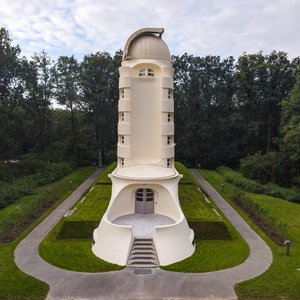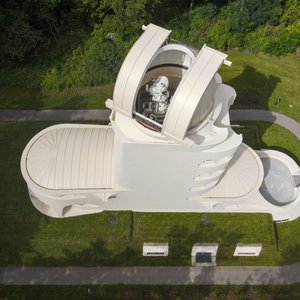Einstein Tower
Overview
The Solar Observatory Einstein Tower (“Einsteinturm”) – a laboratory for spectro-polarimetry – was the first important work of the famous architect Erich Mendelsohn. It was designed and built during the years 1919 to 1924 in collaboration with the physicist Albert Einstein and the astronomer Erwin Finlay-Freundlich.
One may argue whether it makes sense to define the building in terms of architectual style. The tower is often called the “main example for architectual expressionism”. Its overall design is very harmonic, however, and Mendelsohn's own perception was different. In this aspect, everyone has to find their own answer.
The Einstein Tower is a functional building – a solar observatory. Until the second World War it was the most prominent research institution of that kind in Europe. The tower is therefore also an example of the very few connections between science and art, as Mendelsohn fulfilled the conditions for the scientific use as well as his own concepts of form. Due to Mendelsohn's interest in Einstein's work, some of the spririt of the exciting developments in modern physics is also captured in the building. It was originally built in order to prove the redshift of solar spectral lines, as predicted by Einstein’s theory of relativity. However, without a proper understanding of solar convection at the time, the observations remained inconclusive. Between November 1997 and July 1999 the Einstein Tower was repaired and completely renovated, in large part funded by the Wüstenrot Foundation. From 2021 to 2023, a new renovation was necessary, which was also financed and realised by the Wüstenrot Foundation. Since its reopening in September 2023, the solar observatory Einstein Tower has been fully functional again.
The Einstein Tower houses to this day a very efficient 60 cm telescope combined with a long-focus spectrograph. Due to the modernised optical and mechanical equipment, about 400 million colours can be distinguished in the spectrum. Under good conditions, an image resolution of 1″ is achieved. This corresponds to structures 700 km in size on the Sun. A 1€ coin on Earth would theoretically still be recognisable from a distance of 5 km. Observations focus on spectropolarimetric measurements in solar active regions. The analysis of the light's polarisation permits the determination of the magnetic field and radial velocities on the surface of the Sun. The permanent availability of this large telescope, spectrograph and associated laboratory facilities is important for the education of young scientists as well as the development and testing of new spectro-polarimetric equipment for subsequent use at other large telescopes. In this sense, the Einstein Tower is an indispensable complement to the German solar telescopes at Tenerife.
The Einstein Tower is part of the Leibniz Institute für Astrophysik Potsdam (AIP); the remaining area on the Telegrafenberg is used by the German Research Center for Geosciences (GFZ), the Potsdam Institute for Climate Impact Research (PIK) and the Alfred Wegener Institute for Polar and Marine Research (AWI).
On the occasion of the 100th birthday of the Einstein Tower since its opening in 1924, some pictures from its history and from today are compiled on the following page: 100 years Einstein Tower.



Visit
The “Science Park Albert Einstein” is open to visitors during the day, guests must register at the entrance. An outside visit of the tower is possible at any time and highly recommended. More on the page Visiting the Einstein tower.
A digital tour gives everyone the possibility to virtually visit the Einstein Tower and discover its history any time: "Einsteinturm Revisited" - https://einsteinturm.com/.
You can browse historical photographic plates, some of them from the Einstein Tower, here: https://public.aip.de/historical-sky/en/
Acknowledgements
The restoration of the Einstein Tower in 1997-99 and in 2021-23 was made possible by the support of the Wüstenrot Foundation, which, together with the AIP, managed the construction work and the preservation work. Most of the costs were borne by the foundation, which supports the restoration of various monuments.